The Cook's Illustrated Cookbook (338 page)
Read The Cook's Illustrated Cookbook Online
Authors: The Editors at America's Test Kitchen
Tags: #Cooking

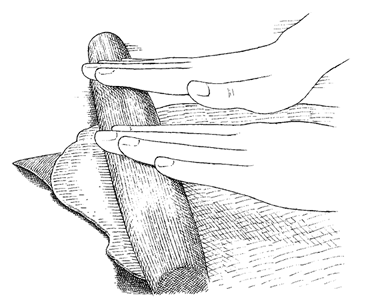
1.
Roll dough out onto 16 by 12-inch piece of parchment paper.
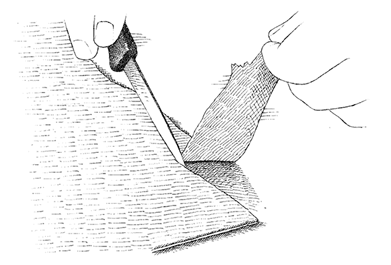
2.
Trim dough so that edges are even with parchment.
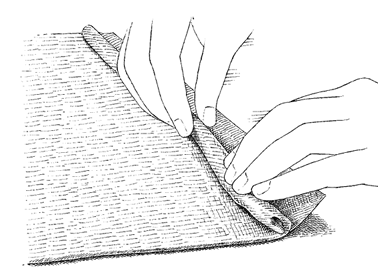
3.
Roll up 1 inch of each edge to create ¹⁄
2
-inch-thick border on all sides. Transfer dough and parchment to rimmed baking sheet.
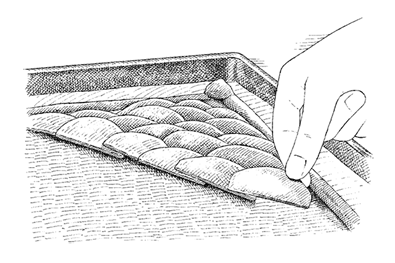
4.
Starting in 1 corner, shingle sliced apples on diagonal to form even row over dough, overlapping each row by one-third.
![]() WHY THIS RECIPE WORKS
WHY THIS RECIPE WORKS
While regular pie crust is tender and flaky, classic tart crust should be fine-textured, buttery-rich, crisp, and crumbly—it is often described as being shortbreadlike. We set out to achieve the perfect tart dough, one that we could use in a number of tart recipes. We found that using a stick of butter made tart dough that tasted great and was easy to handle, yet still had a delicate crumb. Instead of using the hard-to-find superfine sugar and pastry flour that many other recipes call for, we used confectioners’ sugar and all-purpose flour to achieve a crisp texture. Rolling the dough and fitting it into the tart pan was easy, and we had ample dough to patch any holes.
See “FITTING TART DOUGH INTO THE PAN” illustrations that follow recipe.
MAKES ENOUGH FOR ONE 9-INCH TART
Tart crust is sweeter, crispier, and less flaky than pie crust—it is more similar in texture to a cookie.
1 | large egg yolk |
1 | tablespoon heavy cream |
¹⁄ | teaspoon vanilla extract |
1¹⁄ | cups (6¹⁄ |
²⁄ | cup (2²⁄ |
¹⁄ | teaspoon salt |
8 | tablespoons unsalted butter, cut into ¹⁄ |
1.
Whisk egg yolk, cream, and vanilla together in bowl. Process flour, sugar, and salt together in food processor until combined, about 5 seconds. Scatter butter over top and pulse until mixture resembles coarse cornmeal, about 15 pulses. With machine running, add egg mixture and continue to process until dough just comes together around processor blade, about 12 seconds.
2.
Turn dough onto sheet of plastic wrap and flatten into 6-inch disk. Wrap tightly in plastic and refrigerate for 1 hour. Before rolling dough out, let it sit on counter to soften slightly, about 10 minutes. (Dough can be wrapped tightly in plastic wrap and refrigerated for up to 2 days or frozen for up to 1 month. If frozen, let dough thaw completely on counter before rolling it out.)
3.
Roll dough into 11-inch circle on lightly floured counter (if at any point dough becomes too soft and sticky to work with, slip dough onto baking sheet and freeze or refrigerate until workable). Place dough round on baking sheet, cover with plastic, and refrigerate for about 30 minutes.
4.
Remove dough from refrigerator; discard plastic but keep dough on baking sheet. Loosely roll dough around rolling pin and gently unroll it onto 9-inch tart pan with removable bottom, letting excess dough hang over edge. Ease dough into pan by gently lifting edge of dough with 1 hand while pressing into corners with other hand. Leave any dough that overhangs pan in place.
5.
Press dough into fluted sides of pan, forming distinct seam around pan’s circumference. (If some sections of edge are too thin, reinforce them by folding excess dough back on itself.) Run rolling pin over top of tart pan to remove any excess dough. Wrap dough-lined tart pan loosely in plastic, place on large plate, and freeze until dough is fully chilled and firm, about 30 minutes, before using. (Dough-lined tart pan can be wrapped tightly in plastic and frozen for up to 1 month.)
6.
Adjust oven rack to middle position and heat oven to 375 degrees. Set dough-lined tart pan on rimmed baking sheet. Spray 1 side of double layer of aluminum foil with vegetable oil spray. Press foil greased side down into frozen tart shell, covering edges to prevent burning, and fill with pie weights.
7A. FOR A PARTIALLY BAKED SHELL:
Bake until tart shell is golden brown and set, about 30 minutes, rotating baking sheet halfway through baking. Transfer tart shell with baking sheet to wire rack and carefully remove weights and foil. Use crust while it is still warm or let it cool completely (see individual tart recipe instructions).
7B. FOR A FULLY BAKED SHELL:
Bake until tart shell is golden brown and set, about 30 minutes, rotating baking sheet halfway through baking. Carefully remove weights and foil and continue to bake tart shell until it is fully baked and golden, 5 to 10 minutes longer. Transfer tart shell with baking sheet to wire rack and let tart shell cool completely, about 1 hour.
Substitute ¹⁄
4
cup Dutch-processed cocoa for ¹⁄
4
cup flour.
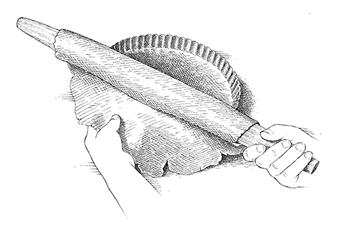
1.
After rolling out dough, loosely roll it around rolling pin, then gently unroll it evenly onto tart pan.
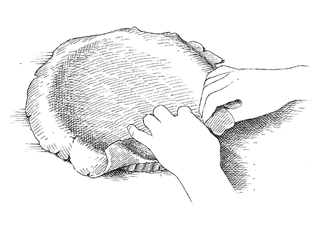
2.
Lift up edges of dough and ease it down into corners of pan.
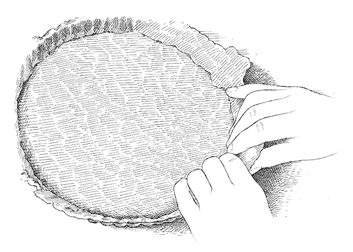
3.
Press dough into fluted sides of pan.
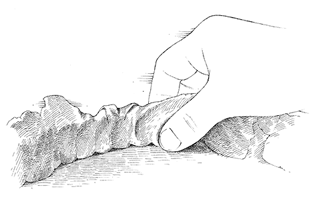
4.
Reinforce any thin areas of edge by folding dough back on itself.
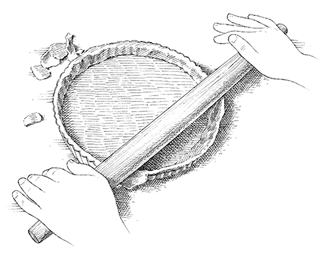
5.
Run rolling pin over top of tart pan to remove any excess dough.
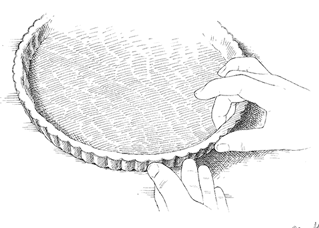
6.
Finished edge should be ¹⁄
4
inch thick. If it is not, press dough up over edge and trim excess.
